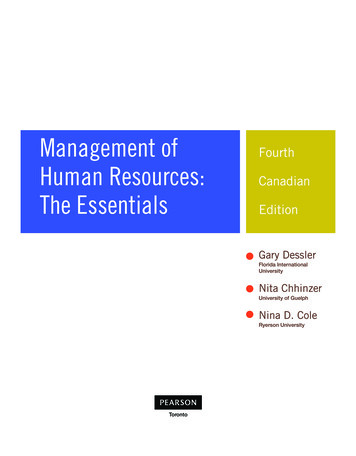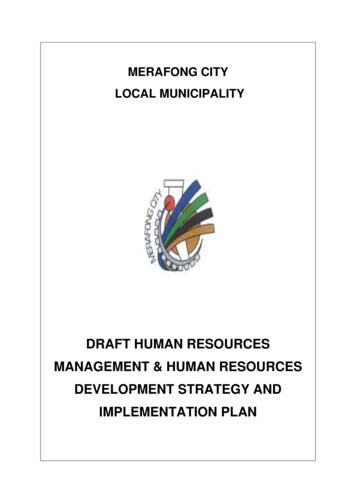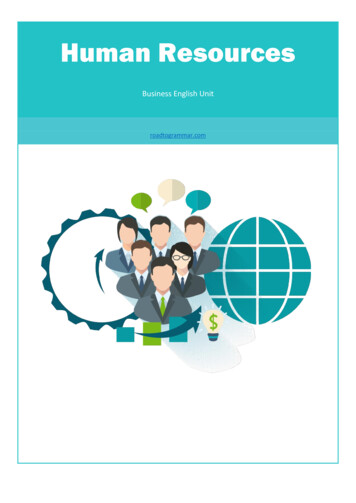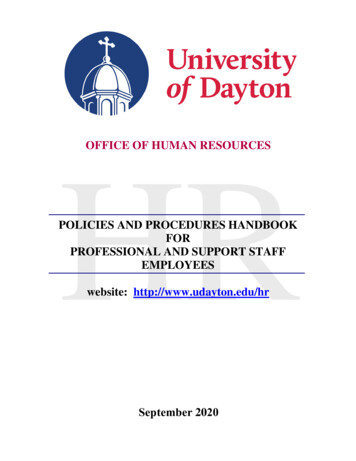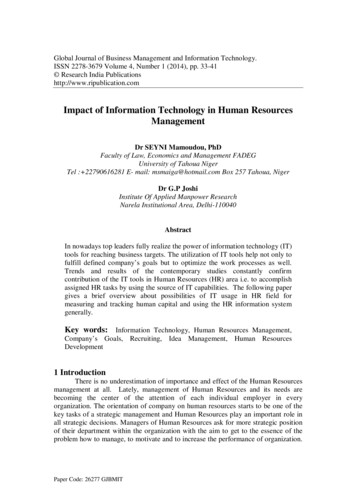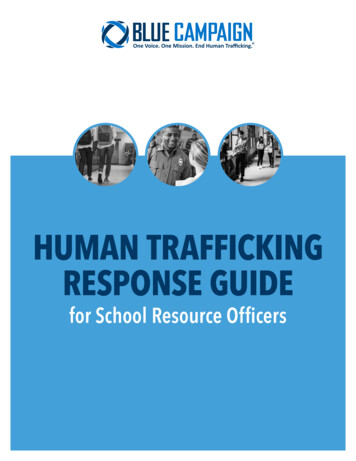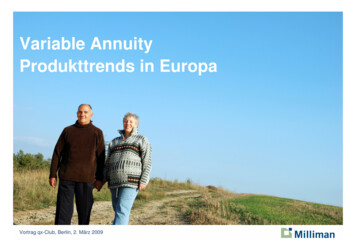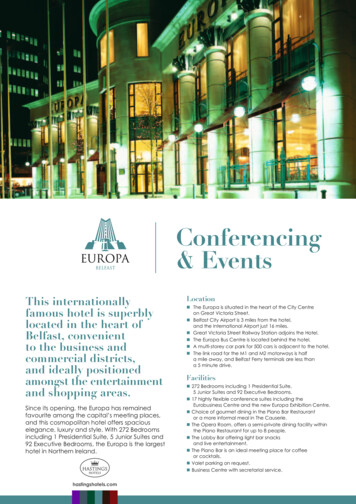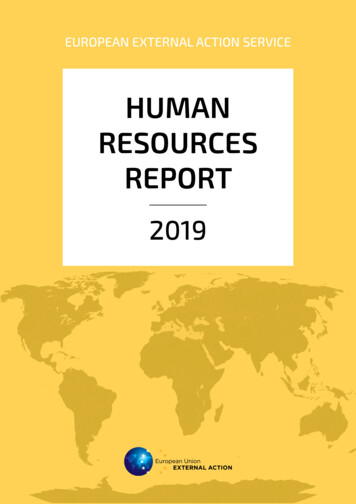
Transcription
EUROPEAN EXTERNAL ACTION SERVICEHUMANRESOURCESREPORT2019
2019HUMAN RESOURCES REPORTEuropean External Action Service
About this reportThis is the annual Human Resources Report of theEuropean External Action Service (EEAS) for theyear 2019. This report provides an overview of themain administrative and policy developments asregards human resources as well as detailed statistics on the EEAS population.To access previous reports you can visit the EEASwebsite.July 2020
CONTENTSFOREWORD 6ORGANISATIONAL DEVELOPMENT 7Organisation and Structure 8Resource Allocation 8Network of EU Delegations 9Administrative Support 9Cooperation and Synergies 10TALENT MANAGEMENT 12Attracting and sourcing talent 13Exchange Programmes 16Developing and retaining talent 17Career Development 20WORKING ENVIRONMENT 22Disability policy 23Anti-harassment policy 24Mediation 24Social policy 25Ethics 25Rights and obligations 25Work-life balance 25Medical Assistance 26Working conditions for local agents 27STAFF MATTERS 28Social Dialogue 29Internal Communication 30Staff Survey 30INFRASTRUCTURE, SECURITY AND INFORMATION SYSTEMS31Infrastructure 32Security 33Secure communications 34Information systems 35EEAS POPULATION 36Distribution of staff by category37Distribution of staff by gender 39Distribution of staff by nationality41Distribution of staff by age 46Management staff 50ANNEXES 54
FOREWORDIn 2019, following the European Parliamentelections, the EEAS welcomed the appointment of Mr Josep Borrell Fontelles as HighRepresentative of the Union for Foreign Affairs and Security Policy/Vice President ofthe European Commission (HR/VP). I wouldlike to take this opportunity to express tohim my sincere congratulations and a warmwelcome. The EEAS Directorate-General forBudget and Administration (DG BA) is committed, more than ever, to maintaining itshigh standards of performance in the serviceof the HR/VP and the European Union (EU).In 2019, the EU also has had to prepare itselffor becoming a Union of 27, following the departure of the United Kingdom (UK). Amongone of its most important tasks, DG BA addressed the human resource (HR) challenges this imposed, and launched preparationsto ensure the EU diplomatic presence in thecountry. At the same time, the EEAS successfully expanded the representation of the EUin the world, with the opening of the Delegation to Kuwait and the Delegation to Turkmenistan.Throughout these fast changing politicalpriorities, the need to ensure a respectfulworking environment for our staff, one thatfosters creativity and innovation, remainshigh on our agenda. In 2019, we built furtheron our ambition to become a gender-balanced service and successfully decreasedthe gender gap in decision-making positions. But, we are not there yet. We need tocontinue to challenge ourselves and to reinvent ways to become a service of equality,not only as regards gender, but also on allfronts. In 2019, we launched new initiativestowards inclusion, with a focus on personswith disabilities, as we believe that embracing diversity is a key to success.6Once again, we fully committed ourselvesto investing in the development of our staff,both personally and professionally. We further advanced on the implementation of theroadmap on equal opportunities and careerdevelopment, and we appointed a careeradvisor at the service of staff. Specialisedcareer guidance and training maps are nowavailable for different categories of staff, toimprove and support their career prospects.Linked to this, we launched new traininginitiatives, beyond classroom learning, toenable the active participation of our colleagues in Delegations though online training.I recognise that we ask a great deal from ourstaff, and I would like to thank them for theircontinued effort and dedication. Not least ofall, I would like to thank our partners in other EU institutions, without whose unfailingsupport many of the achievements in thisreport would not have been possible.We will continue to work with the samededication and energy, and look forward tolaunching future initiatives with the samecreativity to support the work of the HR/VPand the EEAS in representing the EU and itscitizens around the globe.Gianmarco Di VitaDirector–General for Budget andAdministration
ORGANISATIONALDEVELOPMENT7
EEAS HUMAN RESOURCES REPORT 2019ORGANISATION AND STRUCTURE2019 brought several organisational improvements to the EEAS. Particularly noteworthy werethe advances in the EU common security and defence policy, which required an administrative reform of its Crisis Response and Common Securityand Defence Policy structures (CSDP-CR), restructuring the existing Directorates along the followingthree pillars: policy, planning and operations. Theresulting CSDP-CR Department under the DeputySecretary-General CSDP-CR has two new Directorates: the Directorate for Security and DefencePolicy (SECDEFPOL) and the Directorate for Integrated Approach for Security and Peace (ISP). Thereorganisation did not affect the Civilian Planningand Conduct Capability (CPCC) Directorate, nor theEuropean Union Military Staff (EUMS).With the new SECDEFPOL Directorate, the EEAShas established a single-entry point for all securityand defence issues, facilitating interactions withthe European Commission, the EU Member Statesand external partners. The role of the new ISP Directorate is to facilitate the implementation of theintegrated approach and to ensure continuity andcoherence of engagement throughout the conflictcycle.Within the same reorganisation, the Space TaskForce was placed directly under the EEAS SecretaryGeneral to acknowledge its specific, and broader,relevance beyond security and defence, and theSanctions Policy Division was placed under theDirectorate for Inter-institutional relations, policycoordination and public diplomacy (SG.AFFGEN).In addition, the Intelligence Analysis and Reporting Directorate (INTCEN) was directly attached tothe HR/VP to better reflect its role as main sourceof intelligence-supported strategic situationalawareness, analysis and forecasting for the EEASand other EU institutions.In July 2019, the EEAS created the new Mission Operational Support Division (CPCC.4) under the CPCCDirectorate to reflect commitments under the Civilian Compact and the relevant Action Plan in thehuman resources area of Civilian Missions.Another noteworthy organisational innovationwas the decision of the EEAS Secretary General inSeptember 2019 to create a Career Adviser entityunder the DG BA, as well as the appointment of anEEAS Career Adviser/Talent manager. The new Adviser is responsible for advising colleagues of allcategories and functions, both in headquarters(HQ) and in Delegations, on their career and professional development options, in close cooperation with the Career Advisory Service available inthe HR Directorate.RESOURCE ALLOCATIONIn 2019, efforts to optimise resource allocationwithin the organisation continued and included aseries of actions.The Annual Review Mechanism, initially launchedin 2017 to improve the function of the organisationand ensure adequate resourcing of political priorities, turned its focus to improving the functioningof EU Delegations. In 2019, to ensure business continuity and autonomous administrative sections,the Annual Review Mechanism targeted the presence of a “minimal kit” of two Administrators (AD)and two Assistants (AST) or contract agents in allDelegations.Since posts can only be mobilised via transfersbetween Delegations, redeployments from HQ orincreased budget allocation, the HR Directoratecoordinated closely with the departments con-8cerned and identified the need for 13 new posts in11 Delegations. All agreed that these posts shouldbe established and filled, at the latest by the 2021rotation exercise.Meanwhile, and with the view to reduce relianceon seconded national experts with a generalistprofile, the EEAS adopted a policy to limit the proportion of seconded national experts outside thespecialised departments of crisis managementand strategic communications or in other highlyspecialised fields.Given the current scarcity of human resources, theHR Directorate carried out a screening of the distribution of secretarial support at HQ with the viewto optimising the functioning of the organisationand better distributing scarce administrative resources with the aim to distribute resources fairly
ORGANISATIONAL DEVELOPMENTand provide adequate support for all services. Thescreening provided the basis for some redistribution of administrative support amongst departments and between HQ and Delegations.Finally, the EEAS is operating in an unpredictablepolitical context and with significant budgetaryconstraints. With this in mind, a policy for more ag-ile management of resources was launched. Thisprovides a framework for improving response capacity and agility to face extraordinary situationsof a temporary character, such as specific crises,intense negotiation phases, or summits. This policy should facilitate swift and flexible mobilisationof resources in the short, medium and longer term,as required.NETWORK OF EU DELEGATIONS“In 2019, the EEAS strengthenedthe EU presence in the Middle East and inCentral Asia with the opening of Delegations in Kuwait and Turkmenistan.The EU established its presence in Kuwait in July2019. This decision was based on the shared interest in a substantial upgrading of bilateral relations,and on the fact that the Gulf countries are not onlyimportant economic and trade partners for the EU,but also central actors in the EU neighbourhoodpolicy. The presence in Kuwait also allows the EEASto distribute better the tasks of representation andpresence in the region, as the new Delegation alsocovers Qatar, whilst the Delegation in the Kingdomof Saudi Arabia had hitherto been responsible forboth countries.In addition, following a continued strengtheningof the partnership and cooperation with Turkmenistan, the EU opened its 142nd Delegation thereduring the second semester of 2019.As regards the opening of a Delegation to the UKfollowing Brexit, preparations continued in 2019in close cooperation with stakeholders in the European Commission and the European Parliament.Finally, there were some adjustments to the network of Delegations in the Africa region. Accreditation to Equatorial Guinea was transferred fromthe Delegation to Gabon to the Delegation to Cameroon, allowing for improved connections to thecountry. Furthermore, efforts towards ensuringthe opening of an EU office in Saõ Tomé and Príncipe continued.ADMINISTRATIVE SUPPORTPLANNING AND REPORTINGincluding fraud, associated with achieving organisational objectives.In 2019, the EEAS introduced a number of new approaches to support the modernisation of the administration and its functioning.The EEAS has stepped up analysis of the contentof Annual Management Plans (AMP) and has improved follow-up and assistance. AMPs oftencontain early warnings about resource issues andrisks, and the DG BA followed up any salient information with the divisions concerned. This was animportant opportunity to reach out to both Managing Directorates and Delegations and allowed forproviding support and guidance on a wide range ofissues (infrastructure, information security, physical security, resource allocation, administrativesupport, training etc.).The new Internal Control framework, officially adopted in October 2018, entered into force in 2019.The added value of the new framework is its increased flexibility and capacity to focus on therole of individuals as first line of defence againstwrongdoing, serious irregularities and bad management. It also provides important contributionsto strategy setting, planning and operational performance, and the framework principles contribute to the reduction of internal and external risks,One innovation of the AMPs for Delegations was9
EEAS HUMAN RESOURCES REPORT 2019to introduce a way to measure the performance ofdiplomatic activities carried out by Delegations under the Lisbon Treaty, such as demarches, coordination with Member States, and visits. These measurements can help quantify the assets used andtime spent implementing these responsibilities, akey aspect of the activities on the ground.Innovation also means new tools: in November2019, in view of simplifying the reporting systemand guaranteeing easier analysis of data, the EEASlaunched a new reporting portal for the annualDeclaration of Assurance. With this portal, Delegations were able to complete the internal controlquestionnaire, the registration of non-complianceand exceptions, and the declaration of assurancefor the year.SUPPORT TO DELEGATIONSThe internal evaluation of the Regional Centre Europe (RCE) in July 2018 triggered a wider internalreflection exercise within DG BA regarding possibleways to modernise and simplify the overall model of administration and increase efficiency. DG BAlaunched an exercise, named “Innovative 2019”, inDecember 2018. Approximately 20 working groupsworked to determine methodology, establish risksand opportunities, and propose roadmaps for implementation on a series of issues. The RCE ledseveral of these working groups, including on global procurement procedures, and the centralisationof Art.23 of the Staff Regulations of Officials andthe Conditions of Employment of Other Servants(Staff Regulations / CEOS).In June 2019, each working group submitted conclusions to the Directors of DG BA and a concreteaction plan was drawn up, which included implementation deadlines and resource requirements.In addition, the RCE contributed to the work of theDelegations beyond its strict geographical mandate, by actively supporting the creation of mergedadministration sections (Common AdministrativeSections) for the Delegations of Jordan/Yemenand Lebanon/Syria. The RCE also provided supporton human resources, finance and procurementtasks to the Delegations in Trinidad and Tobago,Congo-Brazzaville, Lebanon and the United ArabEmirates.With regards to its support to regionalised Delegations, in 2019 the RCE processed 1,918 Art.23accommodation payments, 2,362 medical claims,completed curriculum vitae (CV) screenings for 28posts, processed five end-of-contract calculationsand performed three establishment of rights fornewly recruited local agents or end of contracts,completed 10 salary reviews, and optimised thefunctioning of payroll for 11 Delegations. The RCEalso managed 20 high value procurement procedures and 70 low or medium value tenders andprovided assistance on 69 different topics. In total, the RCE processed 7,296 transactions in 2019,17.3% more than in 2018.COOPERATION AND SYNERGIESHR NETWORKIn 2019, the EEAS cooperated closely with EU Member States on human resources matters via the HRDirectors’ Network. This forum provided an excellent opportunity to exchange ideas and learn fromother HR professionals, and to address HR relatedchallenges faced by diplomatic services.To revitalise the Network and better draw on theexpertise of its members, the format of the meetings was adjusted to a more policy-focussed debate. In 2019, the Network concentrated on theissue of improving conditions for spouses accompanying staff posted abroad.The Network had several group discussions with10Member States on options for spouse employment, administrative conditions (e.g. work visafor spouses) and access to information/supportstructures. The HR Network agreed on a draft action plan on options for spouses in December 2019,with volunteering Member States leading on several actions.EUDEL STEERING COMMITTEEThe combined force of the EEAS and the EuropeanCommission staff in Delegations advances EU interests as a whole. Nearly two-thirds of the morethan 6,000 staff members employed in EU Delegations are from the European Commission. Asdecisions on the network of EU Delegations affect
ORGANISATIONAL DEVELOPMENTstaff members of both institutions, it is essentialthat the EEAS and the European Commission cooperate closely on HR management. The role of theSteering Committee for EU Delegations (EUDEL1)is to ensure that polices and decisions that applyseparately to the two populations ideally mirrorone another, or that they are at least coherent andconsistent, and that decisions and policies takeinto account the interests of both populations.The EEAS attributes great importance to a consistency of rules, tools and support, to ensurethat all staff in Delegations benefit from the bestpossible conditions within existing budgetary andregulatory constraints, so that they can performtheir tasks effectively. To achieve this, cooperationbetween the EEAS and the European Commissiondevelops at different levels during the lifecycle ofpolicy making through the EUDEL, allowing for discussion, finalisation and endorsement of decisionsaffecting Delegations. The EUDEL met four times in2019 at Director level and once at Head of Division/Head of Unit level.In 2019, EUDEL meetings focused in particular onthe reform of conditions for local agents. The aimof the reform is to redefine and harmonise local agents’ conditions of employment across theworld. To ensure that Commission and EEAS hada shared understanding of the objectives of thereform, and with a view to implementing it effectively, several joint working groups and informalconsultation mechanisms were used throughoutthe process, from the drafting to the finalisationphase.The EEAS and the European Commission also cooperated closely on issues such as implicationsof Brexit/opening of the new Delegation to theUK, teleworking, anti-harassment policies, homeleave, and on the planning of transfer of regionalcooperation functions from the Delegation to Nicaragua to the Delegation to Costa Rica.1 The EUDEL is chaired by the EEAS and brings around the table representatives from: the Directorate-General for International Cooperationand Development (DG DEVCO), the Directorate-General for Trade (DG TRADE), the Directorate-General for Neighbourhood and EnlargementNegotiations (DG NEAR), the Secretariat-General of the European Commission, the Directorate-General for Budget (DG BUDG), the Directorate-General for Human Resources and Security (DG HR), the Directorate-General for European Civil Protection and Humanitarian Aid Operations (DG ECHO) and the European Commission Service for Foreign Policy Instruments (FPI).11
TALENTMANAGEMENT12
TALENT MANAGEMENTEEAS staff is comprised by five main categories:officials, temporary agents, contract agents, localagents and seconded national experts, who oversee or assist in the daily work of the EEAS in HQ andin Delegations. At the end of 2019, 1,252 officials,1,058 local agents, 497 contract agents, 461 seconded national experts and 333 temporary agentswere working in the EEAS.The work of the EEAS is complemented by othersupport personnel, like external staff, trainees andjunior professionals. Together, a total of 2,082 personnel in HQ and 2,392 in Delegations were working in the EEAS at the end of 2019.Detailed reporting on the nationality, gender, ageand evolution of EEAS staff is available in pages 37- 53 of this report.ATTRACTING AND SOURCING TALENTOFFICIALS AND TEMPORARY AGENTSoverall proportion to 21.8%, slightly above theirshare in the EU population (20.2%).—— Publication of postsFor the AST and AST/SC posts, 29.4% applicantswere from the EEAS, 58,4% from other EU institutions and 12% were from an EPSO reserve list.In 2019, the EEAS published 162 posts outsidethe mobility exercise in the AD, AST and AST/SCcategories, including 21 AD positions at management level. Out of the 1471 applications, 42,2% fornon-management posts and 31,3% for management posts were women.Out of the candidates selected for these posts, 47%were women. As regards their origin, 43% werefrom the EEAS, 31% were diplomats from Member States, 22% from other EU institutions and 4%from an EPSO reserve list.Out of the applicants to AD posts, 25% were fromthe EEAS (including temporary agents from Member States working in the EEAS), 43% were diplomats from Member States, 27% from the EuropeanCommission and other EU institutions and 5% froma reserve list of the European Personnel SelectionOffice (EPSO). For the AST and AST/SC posts, 19%applicants were from the EEAS, 49% from other EUinstitutions and 32% from an EPSO reserve list.39% of the candidates selected for these postswere women. As regards the origin of the selectedcandidates, 33.3% came from the EEAS, 27.5% fromMember States 19.6% from other institutions and19.6% of them from an EPSO reserve list.In Delegations, the EEAS published 69 positionsoutside the rotation exercise (below), includingnine at management level. Out of the 789 applications the EEAS received for these posts, the proportion of female applicants was 46,5% for non-management posts and 24,8% for management posts.23% of the applicants to AD posts were from theEEAS (including temporary agents from MemberStates), 35% were diplomats from Member States,41.6% from the European Commission, the European Parliament and other EU institutions and 0.4%from an EPSO reserve list. 26.5% of the newly-recruited AD came from the Member States whojoined the EU in 2004 or later (EU13) bringing their—— Temporary agentsSuccessful candidates on AD posts from the National Diplomatic Services are recruited as temporary agents (Member States’ diplomats).Four temporary agents occupying managementpositions and 25 in non-management positionswho finished their contracts in 2019 received asecond contract after succeeding in a selectionprocedure. Through external publications and the2019 rotation exercise, the EEAS recruited 57 newdiplomats from Member States, including 13 onmanagement posts.In 2019, the distribution of temporary agents onmanagement posts remained imbalanced betweenHQ and Delegations. In order to address the imbalances, the EEAS aims at recruiting more temporaryagents on middle management positions in HQ.“For the 2019 rotation exercise, 168candidates from Member States appliedto management posts. 57 of them camefrom the EU13 Member States.13
EEAS HUMAN RESOURCES REPORT 2019—— Mobility exerciseThe mobility exercise allows for staff members tochange post in HQ, in principle after four years inthe same post and for the reintegration of staffmembers returning from Delegations. Mobility canbe anticipated or postponed for one additional yearconsidering the needs of the service, the overall HRsituation and planning of the department. AST officials may take part in the mobility exercise on avoluntary basis.In the framework of the 2019 mobility exercise,the EEAS published 66 AD, 32 AST and eight AST/SC posts. A total of 87 candidates applied, amongwhich, 81% of the AD and 83% of the AST got a postamong their six priorities.Furthermore, the EEAS also undertook a management mobility exercise in 2019, with the participation of 10 returning Heads of Delegation, sevenDeputy Heads of Delegation, one manager in HQand 11 former managers who were also eligible toparticipate. 14 of them were appointed Heads ofDivision, and eight were appointed to different advisor or equivalent posts.—— Rotation exerciseThe rotation exercise enables the EEAS to fill positions in Delegation and organise the movementsbetween Delegations. The rotation exercise isguided by similar principles as the mobility exercise, namely to allow EEAS staff to develop a mixof competences through posts in various fields andgeographic areas, in both HQ and Delegations.The 2019 rotation exercise was launched on 13July 2018. A total of 930 candidates applied to 181posts: 400 candidates to AD management, 317 toAD non-management, 125 to Head of Administration and 88 to assistant to Head of Delegationposts.Regarding the origin of the candidates applying toAD posts in Delegations, 51% applications for management and 50.6% for non-management positions came from Member States (applications fromtemporary agents already serving with the EEASincluded). In addition, applicants to managementand non-management posts respectively included 28.5% and 29.4% from the EEAS, 11.5% and 16%from the European Commission and 2.5% and 4%from other EU institutions.Regarding gender, 23% of applicants for management posts, 33% for AD non-management posts,46% for Heads of Administration and 82% for assistant to Head of Delegation were women.As a result of the rotation exercise, 148 candidateswere appointed: 50 in management positions ofHead and Deputy Head of Delegation out of which28% were women, 59 in non-management postspositions with 30.5 % women, 22 in Head of Administration posts with 27% women and 17 inassistant to Head of Delegation posts with 94%women. Among the AD appointees, 50% were EEASofficials, 47.2% Member States officials includingtemporary agents and 2.8% from other EU institutions. Finally, the European Commission secondedfour officials to occupy a Head of Delegation position.CONTRACT AGENTSThroughout 2019, the EEAS recruited 102 new contract agents, 78 in HQ and 24 in Delegations. Under an agreement with the European Commission,and in the spirit of loyal cooperation between theinstitutions, the EEAS undertook to finance 11 newcontract agent posts in 2019, to reinforce servicesat HQ dealing with disinformation. Moreover, fournon-military seconded national experts’ postswere replaced by contract agents.Through the 2019 mobility exercise for contractagents in Delegations, the second compulsory mobility exercise, 16 contract agents moved to a newpost. Despite the challenges posed by the limitednumber of participants and available posts, the exercise was assessed as overall positive.LOCAL AGENTSIn 2019, 197 local agents joined Delegations, mainlyin function groups2 1 and 3. In the same period, 170local agents left Delegations after spending an average of 10 years working for the EU. Out of 2,295eligible local agents, 354 were promoted (113 fromthe EEAS and 241 from the European Commission),and 30 local agents moved to a higher functiongroup by applying for a vacant position.2 Local Agents’ duties and responsibilities are based on the different function groups as follows: Group 1 - administrative, advisory and supervisory duties, Group 2 – executive duties, Group 3 – senior clerical duties, Group 4 – clerical posts, Group 5 – skilled manual posts, Group6 – manual posts.14
TALENT MANAGEMENTSECONDED NATIONAL EXPERTSA new concept for theselection of Heads and DeputyHeads of DelegationStarting with the 2018 rotation exercise,the EEAS introduced a new concept forthe selection of Head and Deputy Headof Delegation. The selection is split intotwo parts – a simulation exercise and aninterview. For the simulation exercise,candidates are given a file with information on a complex situation in a fictitiouscontext. The candidates have one hourto prepare a presentation on their analysis and action plan, which then have topresent to the panel and answer to theirquestions. The purpose of the simulationexercise is to assess the following competencies based on the EEAS managementcompetency framework: decisiveness,organising & prioritising, motivating andinspiring others, and effective delegation. The simulation exercise is followedby an interview on the professional expertise of candidates, during which theywere assessed on the following criteria:motivation, specific knowledge of countryand region, knowledge of EU external relations, general knowledge of EU policieswith external impact and staff management skills.In the preparations undertaken in 2019 forthe 2020 rotation exercise, the EEAS introduced a number of compulsory trainingmodules for panel members taking partin interviews for management positions,for example, a training on unconsciousbias and a training to familiarise panelmembers with the details of the respective simulation exercises. Panel membersfrom the EEAS, the European Commission,the Council and Member States participated in the training.Seconded national experts are seconded fromMember States’ administration either ‘cost-free’(salary paid by their Member State except for mission expenses and security costs) or ‘cost-shared’(paid also by the EEAS). In 2019, Member Statesfinanced 43% of the seconded national experts inHQ and 77% in Delegations.“In order to address the concernsexpressed by the European Parliamentthe EEAS adopted a policy that allows forgradual reduction of seconded nationalexpert positions.More specifically, the EEAS adopted the followingmeasures: The EEAS will maintain seconded nationalexperts’ positions for specialised positionslike tackling disinformation and counter terrorism, while more general profiles will beevaluated at the end of the secondment. Thisphasing-out could take place over a four-yearperiod from 2018 to 2021. All cost-free positions that remained vacantfor more than one year, and are not essentialfor business continuity, will be cut. Entities with more than three seconded national expert positions will have the possibility to reduce them when a post becomesvacant. The EEAS will assess the suppression of seconded national experts’ positions that willbecome vacant following Brexit. For transparency and fairness reasons, theEEAS advertised all vacant seconded national expert positions, inviting Member State toshow interest in any position.The EEAS converted in 2019 four cost-shared positions of civilian national experts into contractagents while two remaining conversions will beimplemented in 2020.15
EEAS HUMAN RESOURCES REPORT 2019TRAINEES AND JUNIOR PROFESSIONALSEvery year, junior professionals and trainees jointhe EEAS through different programmes to support its work in HQ and in Delegations.In 2019 the EEAS recruited 60 remunerated BlueBook trainees, in cooperation with the European Commission Traineeshi
This is the annual Human Resources Report of the European External Action Service (EEAS) for the year 2019. This report provides an overview of the main administrative and policy developments as regards human resources as well as detailed sta-tistics on the EEAS population. To access previous reports you can visit the EEAS website. July 2020
